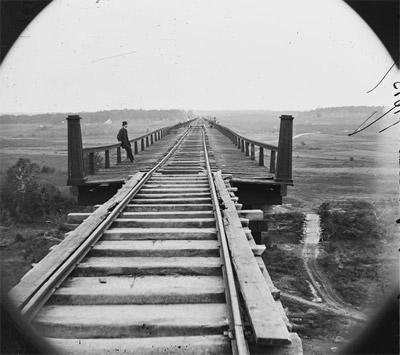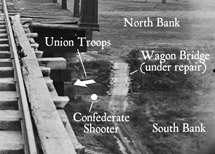Historical Clues: Analysis of Historical Clues

Analysis of Historical Clues
Watching the Shot has a General in the water leading the soldiers and two mounted cavalry across the river, with sword held high. The General's image was added later to the scene as previously noted. The General's image was painted thinly and appears to have faded over time and so any possible distinctions that may have existed in the image are no longer available to positively identify the General in the water as Barlow. Nicolai Cikovsky suggests in the Homer Raisonne that Barlow is the small figure leading the group of soldiers to battle in the painting, Skirmish in the Wilderness, 1864 (5.10). It is difficult to imagine Homer not adding Barlow to his only other battle scene, especially given the abrupt end to the Civil War, thanks in good measure, to his good friend Brigadier General F.C. Barlow.
 Fig. 5-4: A view of the High Bridge and wooden wagon bridge
Fig. 5-4: A view of the High Bridge and wooden wagon bridge(under repair) to the right and below taken just after the war's
end, April 1865, photographed by Timothy H. O'Sullivan.
The view is from the south and looking toward the north.United States Library of Congress
A photograph of the newly recovered bridge is shown from atop the High Bridge and gives one the perspective of how it looked in April 1865, just days after the battle. The new planking has not yet been trimmed, construction bracing is still in place and no railing has yet been put up (Fig. 5-4). But still it bears a distinct resemblance to the bridge illustrated in Watching the Shot. If Homer did choose this location for Watching the Shot he would have been positioned just underneath the railroad bridge on the north side of the river and looking south. From this position clearly the perspective in the painting does not include the High Bridge, which is directly over the artists and our (the viewers) head. This unusual angle allowed Homer to capture the all important wagon bridge battle to the left while leaving the center stage of the canvas for the principals of the title - the watcher, the shooter and the one being shot. The painting mirrors the historical record of the Confederate soldier's ferocious fight for the wagon bridge to gain access to the north side of the river.
 Fig. 5-5: Detail of Fig. 5-4 showing
Fig. 5-5: Detail of Fig. 5-4 showinghow the scene in Watching the
Shot might relate to the High
Bridge and wagon bridge.
It is interesting to note the apparent connections between history and painting. Triangulating Homer's whereabouts with those of Barlow on April 6 and 7, 1865 certainly raises an intriguing question about the wooden wagon bridge below the High Bridge. If Homer was planning another battle scene, as art historians suggest, could this be the wooden wagon bridge in Watching the Shot? At this moment in time further documentation would need to come forward to clearly answer this question. Without additional information the location of the bridge depicted in Watching the Shot cannot be verified absolutely. Whether Watching the Shot is a depiction of the battle for High Bridge, or perhaps some other bridge battle, the painting nonetheless remains a masterful work of art.
Watching the Shot. © 2025 All rights reserved. Terms of Use and Privacy Policy
